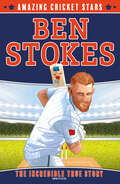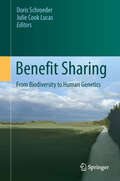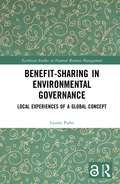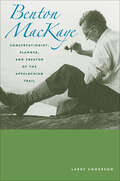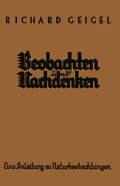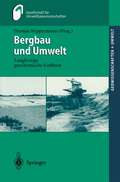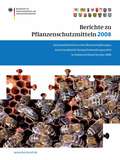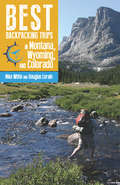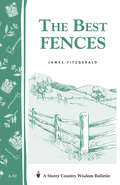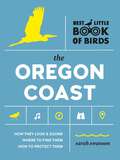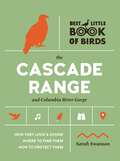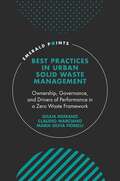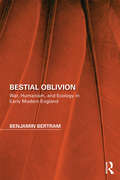- Table View
- List View
Ben Stokes (Amazing Cricket Stars #1)
by null Clive GiffordMeet the king of English cricket, Ben Stokes, in this thrilling unofficial biography! From his childhood in New Zealand and his early cricketing career at Cockermouth, to winning his first County Championship with Durham and selection for England, Ben Stokes’s cricket career has been filled with extraordinary successes alongside great challenges. Follow this impressive all-rounder as he bats, bowls and fields his way to being one of the greatest cricketers of all time – as well as an inspirational England captain. Clive Gifford is a lifelong cricket fan who lives a short walk away from Lancashire’s Old Trafford cricket ground.
Beneficial Co-Utilization of Agricultural, Municipal and Industrial by-Products
by Sally L. Brown J. Scott Angle Lee W. JacobsCo-utilization or blending of residuals offers a unique opportunity to develop products with particular characteristics that are able to target specific customer needs. The very notion of deliberately blending by-products suggests that the recycling and beneficial reuse industries are taking a quantitative step forward towards developing products rather than simply reusing residuals. At the same time that this step provides unique opportunities, it also presents unique challenges. The science associated with the beneficial use of one product may not apply when that product is mixed with another residual. Blending of materials may alter the chemistry of the components of the mixture. This may offer additional benefits, as in the case of disease suppression in composts, or present unexpected problems, as the use of lime-stabilized biosolids has done in Maryland. This book consists of the proceedings of the Beltsville Symposium. The organizers of the Symposium attempted to structure a meeting that would outline both the potential benefits of co-utilization as well as concerns. The editors have divided the proceedings into sections that describe the practical basis for co-utilization of residuals as well as the potential benefits. Specific considerations are described. Finally, case studies include descriptions of successful operations and data that detail results of research involving co-utilization materials. Blending of materials for specific objectives needs to be the focus of any successful co-utilization effort. The scientific implications of the mix need to be determined before a product can be used properly.
Beneficial Insects
by David V. AlfordInsects are key components of life on our planet, and their presence is essential for maintaining balanced terrestrial ecosystems. Without insects humans would struggle to survive, and on a world scale food production would be severely compromised. Many plants and animals depend directly or indirectly on insects for their very survival, and this is particularly so in the case of insectivorous birds and other such creatures. The beneficial role of insects is often overlooked or misunderstood, and in farming circles their very presence on crops is often seen to be unwelcome. In reality, however, many insects are genuinely beneficial, as in the case of parasitic and predacious species. The use of chemical pesticides to control crop pests is becoming more tightly regulated and environmentally undesirable, and low-input farming, in which natural enemies of pests are encouraged to survive or increase, is becoming far more prevalent. Accordingly, Integrated Pest Management (IPM) and Integrated Pest Management (ICM) strategies are increasingly being developed, advocated and adopted. Features: Highlights information on many groups of insects and mites that act as natural enemies or biological control agents of phytophagous insects and mites, including plant pests. Profusely illustrated with high-quality colour photographs. Focuses mainly on insects and mites as natural enemies of plant pests, including parasitic and predacious species that have been accidentally or deliberately introduced in classical biological control programmes. Reviews the role of phytophagous European insects and mites in controlling or managing European plants that have become invasive weeds in other parts of the world, notably North America, Australia and New Zealand.
Beneficial Insects
by David V. AlfordInsects are key components of life on our planet, and their presence is essential for maintaining balanced terrestrial ecosystems. Without insects humans would struggle to survive, and on a world scale food production would be severely compromised. Many plants and animals depend directly or indirectly on insects for their very survival, and this is particularly so in the case of insectivorous birds and other such creatures. The beneficial role of insects is often overlooked or misunderstood, and in farming circles their very presence on crops is often seen to be unwelcome. In reality, however, many insects are genuinely beneficial, as in the case of parasitic and predacious species. The use of chemical pesticides to control crop pests is becoming more tightly regulated and environmentally undesirable, and low-input farming, in which natural enemies of pests are encouraged to survive or increase, is becoming far more prevalent. Accordingly, Integrated Pest Management (IPM) and Integrated Pest Management (ICM) strategies are increasingly being developed, advocated and adopted. Features: Highlights information on many groups of insects and mites that act as natural enemies or biological control agents of phytophagous insects and mites, including plant pests. Profusely illustrated with high-quality colour photographs. Focuses mainly on insects and mites as natural enemies of plant pests, including parasitic and predacious species that have been accidentally or deliberately introduced in classical biological control programmes. Reviews the role of phytophagous European insects and mites in controlling or managing European plants that have become invasive weeds in other parts of the world, notably North America, Australia and New Zealand.
Benefit Sharing: From Biodiversity to Human Genetics
by Doris Schroeder and Julie Cook LucasBiomedical research is increasingly carried out in low- and middle-income countries. International consensus has largely been achieved around the importance of valid consent and protecting research participants from harm. But what are the responsibilities of researchers and funders to share the benefits of their research with research participants and their communities? After setting out the legal, ethical and conceptual frameworks for benefit sharing, this collection analyses seven historical cases to identify the ethical and policy challenges that arise in relation to benefit sharing. A series of recommendations address possible ways forward to achieve justice for research participants in low- and middle-income countries.
Benefit-sharing in Environmental Governance: Local Experiences of a Global Concept (Earthscan Studies in Natural Resource Management)
by Louisa ParksTaking a bottom-up perspective, this book explores local framings of a wide range of issues related to benefit-sharing, a growing concept in global environmental governance. Benefit-sharing in Environmental Governance draws on original case studies from South Africa, Namibia, Greece, Argentina, and Malaysia to shed light on what benefit-sharing looks like from the local viewpoint. These local-level case studies move away from the idea of benefit-sharing as defined by a single international organization or treaty. Rather, they reflect different situations where benefit-sharing has been considered, including agriculture, access to land and plants, wildlife management, and extractives industries. Common themes in the experiences of local communities form the basis for an exploration of spaces for local voices at the international level in the Convention on Biological Diversity (CBD), often argued to be the most open arena to non-state actors, and therefore vital to how local voices may be included at the global level. The book analyzes the decisions of the CBD parties to produce an in-depth reflection on how this arena builds and delimits spaces for the expression of local community themes, and paths for local community participation including community protocols. The book then situates the bottom-up findings in the wider debate about global civil society and deliberative democracy in environmental governance. This interdisciplinary book will be of great interest to students and scholars of environmental politics, environmental law, political ecology and global governance, as well as practitioners and policymakers involved in multilateral environmental agreements.
Benefit-sharing in Environmental Governance: Local Experiences of a Global Concept (Earthscan Studies in Natural Resource Management)
by Louisa ParksTaking a bottom-up perspective, this book explores local framings of a wide range of issues related to benefit-sharing, a growing concept in global environmental governance. Benefit-sharing in Environmental Governance draws on original case studies from South Africa, Namibia, Greece, Argentina, and Malaysia to shed light on what benefit-sharing looks like from the local viewpoint. These local-level case studies move away from the idea of benefit-sharing as defined by a single international organization or treaty. Rather, they reflect different situations where benefit-sharing has been considered, including agriculture, access to land and plants, wildlife management, and extractives industries. Common themes in the experiences of local communities form the basis for an exploration of spaces for local voices at the international level in the Convention on Biological Diversity (CBD), often argued to be the most open arena to non-state actors, and therefore vital to how local voices may be included at the global level. The book analyzes the decisions of the CBD parties to produce an in-depth reflection on how this arena builds and delimits spaces for the expression of local community themes, and paths for local community participation including community protocols. The book then situates the bottom-up findings in the wider debate about global civil society and deliberative democracy in environmental governance. This interdisciplinary book will be of great interest to students and scholars of environmental politics, environmental law, political ecology and global governance, as well as practitioners and policymakers involved in multilateral environmental agreements.
Benton MacKaye: Conservationist, Planner, and Creator of the Appalachian Trail (Creating the North American Landscape)
by Larry AndersonPlanner and originator of the Appalachian Trail and a cofounder of the Wilderness Society, Benton MacKaye (1879-1975) was a pioneer in linking the concepts of preservation and recreation. Spanning three-quarters of a century, his long and productive career had a major impact on emerging movements in conservation, environmentalism, and regional planning. MacKaye's seminal ideas on outdoor recreation, wilderness protection, land-use planning, community development, and transportation have inspired generations of activists, professionals, and adventurers seeking to strike a harmonious balance between human need and the natural environment.This pathbreaking biography provides the first complete portrait of this significant and unique figure in American environmental, intellectual, and cultural history. Drawing on extensive research, Larry Anderson traces MacKaye's extensive career, examines his many published works, and describes the importance of MacKaye's relationships with such influential figures as Lewis Mumford, Aldo Leopold, and Walter Lippmann. This book will appeal to students, scholars, and professionals in preservation, conservation, recreation, planning, and American studies, as well as general readers interested in these subjects.
Benton MacKaye: Conservationist, Planner, and Creator of the Appalachian Trail (Creating the North American Landscape)
by Larry AndersonPlanner and originator of the Appalachian Trail and a cofounder of the Wilderness Society, Benton MacKaye (1879-1975) was a pioneer in linking the concepts of preservation and recreation. Spanning three-quarters of a century, his long and productive career had a major impact on emerging movements in conservation, environmentalism, and regional planning. MacKaye's seminal ideas on outdoor recreation, wilderness protection, land-use planning, community development, and transportation have inspired generations of activists, professionals, and adventurers seeking to strike a harmonious balance between human need and the natural environment.This pathbreaking biography provides the first complete portrait of this significant and unique figure in American environmental, intellectual, and cultural history. Drawing on extensive research, Larry Anderson traces MacKaye's extensive career, examines his many published works, and describes the importance of MacKaye's relationships with such influential figures as Lewis Mumford, Aldo Leopold, and Walter Lippmann. This book will appeal to students, scholars, and professionals in preservation, conservation, recreation, planning, and American studies, as well as general readers interested in these subjects.
Beobachten und Nachdenken: Eine Anleitung Zu Naturbeobachtungen
by Richard GeigelDieser Buchtitel ist Teil des Digitalisierungsprojekts Springer Book Archives mit Publikationen, die seit den Anfängen des Verlags von 1842 erschienen sind. Der Verlag stellt mit diesem Archiv Quellen für die historische wie auch die disziplingeschichtliche Forschung zur Verfügung, die jeweils im historischen Kontext betrachtet werden müssen. Dieser Titel erschien in der Zeit vor 1945 und wird daher in seiner zeittypischen politisch-ideologischen Ausrichtung vom Verlag nicht beworben.
Berichte zu Pflanzenschutzmitteln 2008: Sachstandsbericht zu den Bienenvergiftungen durch insektizide Saatgutbehandlungsmittel in Süddeutschland im Jahr 2008 (BVL-Reporte #4.1)
by Peter BrandtEnde April/Anfang Mai 2008 kam es in Südwestdeutschland zu Bienenvergiftungen, bei denen nach letzten Erhebungen etwa 11.500 Völker von 700 Imkern teilweise erheblich geschädigt wurden. Während der Suche nach den Ursachen richtete sich der Verdacht schnell auf Maissaatgut, das mit dem Insektizid Clothianidin behandelt worden war. Die Analysen des Julius Kühn-Instituts bestätigten den Verdacht. Der Sachstandsbericht zu den Bienenvergiftungen ist eine Publikation des deutschen Bundesamtes für Verbraucherschutz und Lebensmittelsicherheit (BVL).
Berufseignungsfeststellung und Unfallverhütung in der Holzindustrie auf Grund psychotechnischer Prüfverfahren
by Oswald HellerDieser Buchtitel ist Teil des Digitalisierungsprojekts Springer Book Archives mit Publikationen, die seit den Anfängen des Verlags von 1842 erschienen sind. Der Verlag stellt mit diesem Archiv Quellen für die historische wie auch die disziplingeschichtliche Forschung zur Verfügung, die jeweils im historischen Kontext betrachtet werden müssen. Dieser Titel erschien in der Zeit vor 1945 und wird daher in seiner zeittypischen politisch-ideologischen Ausrichtung vom Verlag nicht beworben.
Best Backpacking Trips in Montana, Wyoming, and Colorado
by Mike White Douglas LorainBest Backpacking Trips in Montana, Wyoming, and Colorado provides everything you need to know to organize and execute the best backpacking trips in the Mountain West. Mike White and Douglas Lorain, who have walked every mile of the trails described inside, take readers and hikers into some of the wildest and most scenic backcountry landscapes in the nation and help them design the ultimate trip. Focusing on one-week excursions, the book offers details on all the aspects of trip planning—trail narratives, technical data, maps, gear, food, information on regulations and permits, and more. But it is more than a basic guidebook. Trip information is enriched by valuable and interesting sidebars on history and ecology that will increase appreciation for these natural areas and the people who were instrumental in their discovery or protection. In Best Backpacking Trips in Montana, Wyoming, and Colorado, White and Lorain pass on their knowledge of quality hikes, planning and preparation, and the unique satisfaction of multi-day backpacking. This guide, put into practice, will result in the trip of a lifetime.
The Best Fences: Storey's Country Wisdom Bulletin A-92 (Storey Country Wisdom Bulletin)
by James FitzgeraldSince 1973, Storey's Country Wisdom Bulletins have offered practical, hands-on instructions designed to help readers master dozens of country living skills quickly and easily. There are now more than 170 titles in this series, and their remarkable popularity reflects the common desire of country and city dwellers alike to cultivate personal independence in everyday life.
Best Little Book of Birds: The Oregon Coast (Best Little Book of Birds)
by Sarah SwansonThe Best Little Book of Birds launches a new series of practical, pocket-sized, and beginner-friendly birding guides. The first book in the series highlights the must-see species found at the Oregon Coast.
Best Little Book of Birds The Cascade Range and Columbia River Gorge
by Sarah SwansonEnter the amazing world of birding with this practical, pocket-sized, and beginner-friendly guide to the must-see species found in the Pacific Northwest. From the Olive-sided Flycatcher and Clark&’s Nutcracker to Barrow&’s Goldeneye and more, this easy-to-use book will help you identify the commonly occurring birds that help make the Cascades and Columbia River Gorge natural wonders. While following hiking trails and scenic byways, exploring riverside shorelines or remote forests, you&’ll learn where and when to find the most beautiful birds by their sound, appearance, habitats, and migration habits. Perfect for experienced and budding birders alike, this sleek, compact guide is the ideal travel companion for every trip to the mountains.
Best Little Book of Birds Coastal Washington
by Tamara EnzThis practical, pocket-sized book is a beginner-friendly guide to the amazing birds you can find in the coastal areas of the Evergreen State. Washington&’s coast is teeming with scores of beautiful birds, and the Best Little Book of Birds: Coastal Washington will help you find them. This easy-to-use book will help you identify more than 100 commonly occurring birds that help make the Washington coast the natural wonder that it is. An emphasis on best practices and habitat sustainability help empower conservation and ensure that birding on the coast will be possible for years to come. Perfect for budding and experienced birders alike, this sleek and compact guide is the ideal travel companion for every trip to the coast.
The Best of BB
by BBThe best of BB brings together in one volume some of the best writing and illustration by Denys Watkins-Pitchford - better known as BB. This edition has a larger typeface and improved layout from the original which was published to celebrate BB's eightieth birthday in 1985.This beautiful anthology contains extracts from all his books for adults, and few short extracts from this timeless children's books as well.From stories of wild-fowling in the far north of Scotland to night fishing for carp in dark Midland pools, from his famous books about the white goose, Manka the Sky Gipsy, to the Little Grey Men (winner of the Carnegie Medal) there is something here for everyone who loves the British countryside and its wildlife.
Best Practices in Urban Solid Waste Management: Ownership, Governance, and Drivers of Performance in a Zero Waste Framework (Emerald Points)
by Giulia Romano Claudio Marciano Maria Silvia FiorelliEfficient waste management is crucial for a sustainable future. However, due to population growth and the threat of global climate change, systems of urban waste management are under increasing pressure. For the waste sector, the prospect of transitioning to a circular economy presents an opportunity to promote organizational changes and improve performance, as well as contribute to a more sustainable world. Through the examination of case studies of municipalities and waste management firms across Europe, this book provides an overview of the most innovative best practices in urban waste management. The authors analyze the development and results of collection methods, tariff-setting systems, collaborations with partners and providers, recycling policies, and employees’ and stakeholders’ engagement programs. Given the complexity of urban waste management procedures, analysis is multidisciplinary, encompassing management, environmental and sociological perspectives. Providing an overview of opportunities for knowledge sharing and transfer among firms and municipalities to help them promote best practice, this book is a valuable reference for managers and policy makers in urban waste management.
Best Practices in Urban Solid Waste Management: Ownership, Governance, and Drivers of Performance in a Zero Waste Framework (Emerald Points)
by Giulia Romano Claudio Marciano Maria Silvia FiorelliEfficient waste management is crucial for a sustainable future. However, due to population growth and the threat of global climate change, systems of urban waste management are under increasing pressure. For the waste sector, the prospect of transitioning to a circular economy presents an opportunity to promote organizational changes and improve performance, as well as contribute to a more sustainable world. Through the examination of case studies of municipalities and waste management firms across Europe, this book provides an overview of the most innovative best practices in urban waste management. The authors analyze the development and results of collection methods, tariff-setting systems, collaborations with partners and providers, recycling policies, and employees’ and stakeholders’ engagement programs. Given the complexity of urban waste management procedures, analysis is multidisciplinary, encompassing management, environmental and sociological perspectives. Providing an overview of opportunities for knowledge sharing and transfer among firms and municipalities to help them promote best practice, this book is a valuable reference for managers and policy makers in urban waste management.
Bestial Oblivion: War, Humanism, and Ecology in Early Modern England (Perspectives on the Non-Human in Literature and Culture)
by Benjamin BertramAlthough war is a heterogeneous assemblage of the human and nonhuman, it nevertheless builds the illusion of human autonomy and singularity. Focusing on war and ecology, a neglected topic in early modern ecocriticism, Bestial Oblivion: War, Humanism, and Ecology in Early Modern England shows how warfare unsettles ideas of the human, yet ultimately contributes to, and is then perpetuated by, anthropocentrism. Bertram’s study of early modern warfare’s impact on human-animal and human-technology relationships draws upon posthumanist theory, animal studies, and the new materialisms, focusing on responses to the Anglo-Spanish War, the Italian Wars, the Wars of Religion, the colonization of Ireland, and Jacobean “peace.” The monograph examines a wide range of texts—essays, drama, military treatises, paintings, poetry, engravings, war reports, travel narratives—and authors—Erasmus, Machiavelli, Digges, Shakespeare, Marlowe, Coryate, Bacon—to show how an intricate web of perpetual war altered the perception of the physical environment as well as the ideologies and practices establishing what it meant to be human.
Bestial Oblivion: War, Humanism, and Ecology in Early Modern England (Perspectives on the Non-Human in Literature and Culture)
by Benjamin BertramAlthough war is a heterogeneous assemblage of the human and nonhuman, it nevertheless builds the illusion of human autonomy and singularity. Focusing on war and ecology, a neglected topic in early modern ecocriticism, Bestial Oblivion: War, Humanism, and Ecology in Early Modern England shows how warfare unsettles ideas of the human, yet ultimately contributes to, and is then perpetuated by, anthropocentrism. Bertram’s study of early modern warfare’s impact on human-animal and human-technology relationships draws upon posthumanist theory, animal studies, and the new materialisms, focusing on responses to the Anglo-Spanish War, the Italian Wars, the Wars of Religion, the colonization of Ireland, and Jacobean “peace.” The monograph examines a wide range of texts—essays, drama, military treatises, paintings, poetry, engravings, war reports, travel narratives—and authors—Erasmus, Machiavelli, Digges, Shakespeare, Marlowe, Coryate, Bacon—to show how an intricate web of perpetual war altered the perception of the physical environment as well as the ideologies and practices establishing what it meant to be human.
Betörend, berauschend, tödlich - Giftpflanzen in unserer Umgebung
by Fritz Schade Harald JockuschWussten Sie dass durch Honig schon mal eine Schlacht entschieden wurde? dass sich das Reinheitsgebot für Bier ursprünglich gegen eine einheimische Rauschgiftpflanze gerichtet hat? dass der Wunderbaum Palma Christi ein Eiweiß produziert, das im deutschen Kriegswaffenkontrollgesetz aufgeführt wird? wieviele Pflanzen in Ihrem Hausgarten und in Parks giftig sind? Antworten auf viele spannende Fragen wie diese liefert das Giftpflanzenbuch von Fritz Schade und Harald Jockusch. Der Künstler Schade hat Giftpflanzen nach der Natur mit Farbstiften porträtiert, der Biologe Jockusch informiert über botanische, biochemische und toxikologische Fakten. Die Darstellungen werden durch historische Rückblicke, Anekdoten und eigene Erfahrungen aufgelockert. Im Buch folgt die Anordnung der Arten in etwa der jahreszeitlichen Abfolge des ersten Auftretens auffälliger giftiger Pflanzenteile. Wie die üblichen, mit Fotografien bebilderten Giftpflanzenratgeber dient ihr Buch der Gefahrenvermeidung, betont aber auch das Anschauungs- und Lesevergnügen.Die künstlerischen Darstellungen in diesem Buch verbinden ästhetischen Reiz mit hohem Wiedererkennungswert. Sie können leichter verinnerlicht werden als detailreiche Fotografien. Das gilt vor allem für Kinder, die durch Giftpflanzen besonders gefährdet sind. Neben der blühenden wird die fruchtende Pflanze dargestellt, wenn dies für die Vergiftungsgefahr relevant ist. In die 2. Auflage wurden 12 neue Pflanzenarten aufgenommen, von denen einige derzeit die Öffentlichkeit beschäftigen.
Betörend, berauschend, tödlich - Giftpflanzen in unserer Umgebung
by Fritz Schade Harald JockuschWussten Siedass durch Honig schon mal eine Schlacht entschieden wurde?dass sich das Reinheitsgebot für Bier ursprünglich gegen eine einheimische Rauschgiftpflanze gerichtet hat? dass der Wunderbaum Palma Christi ein Eiweiß produziert, das im deutschen Kriegswaffenkontrollgesetz aufgeführt wird?wie bezaubernd schön viele Giftpflanzen sind?Antworten auf viele spannende Fragen wie diese liefert das Giftpflanzenbuch von Fritz Schade und Harald Jockusch. Der Künstler Schade hat Giftpflanzen nach der Natur mit Farbstiften porträtiert, der Biologe Jockusch hat Fachwissen und Anekdotisches aus Gegenwart und Geschichte zu diesen Pflanzen zusammengestellt. Wie die üblichen, mit Fotografien bebilderten Giftpflanzenratgeber dient ihr Buch der Gefahrenvermeidung, betont aber auch das Anschauungs- und Lesevergnügen. Die Autoren beleuchten botanische, biochemische, historische und anekdotische Zusammenhänge für jede Pflanzenart und informieren so auf unterhaltsame Weise. Im Buch folgt die Anordnung der Arten in etwa der jahreszeitlichen Abfolge des ersten Auftretens auffälliger giftiger Pflanzenteile.Die künstlerischen Darstellungen in diesem Buch verbinden ästhetischen Reiz mit hohem Wiedererkennungswert. Sie können leichter verinnerlicht werden als detailreiche Fotografien. Das gilt vor allem für Kinder, die durch Giftpflanzen besonders gefährdet sind. Neben der blühenden wird die fruchtende Pflanze dargestellt, wenn dies für die Vergiftungsgefahr relevant ist.
